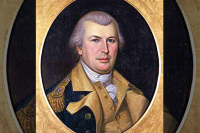Buckeyes both a good luck charm and a poison

A large buckeye tree overhangs and supports the swinging gate leading into and out of our pasture. Since we are constantly getting in and out of our truck to open and shut the gate, we have a chance to observe this tree in all seasons. It always has something interesting going on.
In winter you can spot a buckeye by the large upward-pointing, shiny-brown end buds, larger than the buds on almost any other hardwood. In spring, these buds produce the palmately compound leaves that are the prime identification mark for the tree.
Each May, large showy flower clusters composed of bright yellow petals overhang our gateway. Here in Western North Carolina there are two native species: painted buckeye (Aesculus sylvatica), a shrub, is rarely encountered; and yellow buckeye (A. flava), our common species.
By late August, buckeye leaves turn a rosy salmon. By September the foliage is turning clear yellow, and the tree is starting to drop its large greenish-yellow seedpods. As these dry, the tri-parted husks open to reveal three, beautifully crafted, mahogany-colored seeds from which the tree's name is derived.
On each lustrous “buck's eye’ there’s a round gray scar — the hilum — where the seed was attached inside the husk. Nourishment was fed to the seed via this area. Its resemblance to the pupil of an eye is uncanny, even down to the concentric rings inside each hilum.
Buckeye seeds contain a glycoside that produces a poisonous derivative. Pigs, horses, sheep, and children have been poisoned as a result of ingesting them. The symptoms are inflammation of the mucous membranes, vomiting, twitching, and paralysis.
Related Items
When my wife let her first horse, Surtees, loose in our pasture back in the mid-1970s, he promptly chowed down on all the buckeye seeds around the gate. Before long, Surtees came down with a case of the “wobbles;” that is, he shivered and shook and panted, until he finally toppled onto his side in the grass. He was OK the next morning but no longer eats buckeye.
The Cherokees did once eat quantities of buckeye “meat” after first roasting the seeds, mashing the pulp, and leaching the meal with water for several days. They also threw crushed, raw buckeye into the deep, slow-flowing pools of streams where fish congregated in fall. The glycoside in the mixture stunned the nervous systems of the fish so that they floated to the water's surface, where they were easily gathered. And the Cherokees continue to favor the soft wood of the tree for carving.
Despite their poisonous qualities, buckeye seeds are as pleasing to hold as they are to behold. A flattened place adjacent to the scar allows a person's thumb to settle on it just so. Many people jeep one in their pocket as a good luck charm or talisman. If the fish aren’t biting, rub your buckeye seed just so, spit on your bait, and hang on. When the home team is behind and driving for the winning score in the last seconds, place your thumb on the flattened area just so, hold it there, and see what happens. If you get yourself into the right frame of mind and rub the flattened area just so with your thumb, cash will flow from mysterious sources into your bank account.
(George Ellison is a naturalist and writer. He can be reached at This email address is being protected from spambots. You need JavaScript enabled to view it.)
Editor’s note: This article first appeared in a September 2005 edition of The Smoky Mountain News.









